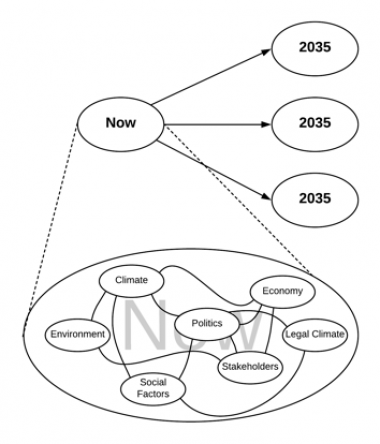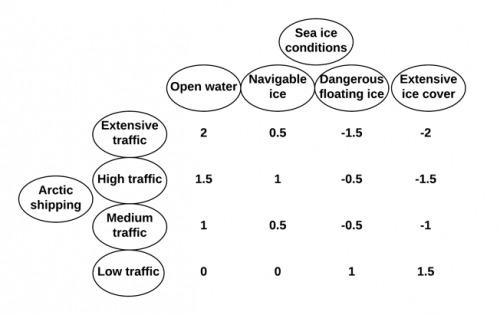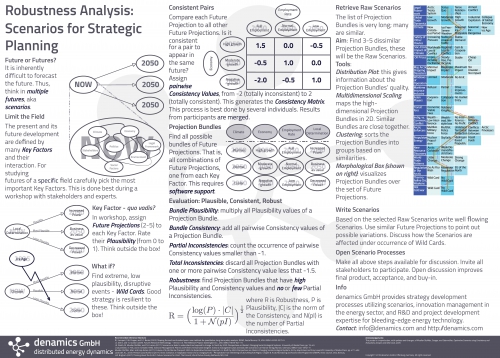The Issue
Policy responses to rapid change must consider complex combinations of social, environmental, political, and economic factors that can determine the future state of the Arctic. Quantitative scenarios offer a transparent and replicable approach to determining plausible combinations of factors that may result in different possible futures.
Why It Matters
Policy decisions need to be informed by science that is not tucked away in the ivory tower but, rather, reflects real-world problems. Planning relevant research in a rapidly changing world—of which the Arctic is the epitome—is important to the well-being of society and the ecosystems. Forecasting is difficult, and best guesses are inadequate, but quantitative scenarios can systematically develop robust, plausible, and consistent pictures of multiple possibilities. This means research can be linked to different potential outcomes and agile policy strategies can be developed to account for more than one possible future state of the Arctic.
State of Knowledge

Scenarios are pictures of the future that form 'a framework for what if–ing that stresses the importance of multiple views of the future in exchanging information about uncertainty among parties to a decision' [1]. In contrast to forecasts—which narrow possibilities to the most likely—scenarios are designed to span the range of possibilities. In this way scenarios are also not visions of what we would like to have happen, but prepare us to respond to multiple possible circumstances.
Scenario techniques are well established as part of the futurist's toolkit [e.g., 1, 2]. There are many different nuances of scenario techniques, but broadly, these can be differentiated as either being qualitative or quantitative. Qualitative scenarios are generally based on the judgment, experiences, and creativity of one or more people. Quantitative scenarios offer a deeper analysis of underlying factors driving the future based on repeatable research, scoring, and calculation. In the best case, quantitative scenarios will also ensure that biases and opinions of project participants are either completely removed or significantly buffered by designing scoring processes such that the futurist may not be able to merely 'engineer' their most likely scenario. One quantitative scenario method is the Robustness-Analysis [3], an elaboration of the Consistency-Analysis [4]. The Robustness-Analysis relies on an iterative process of collecting data through workshops and research to determine the Key Factors influencing the future state of—in this case—the Arctic. Quantifying combinations of the Key Factors allows projections of the possible future states (Future Projections). This process is open to diverse sources of expertise that allows a wider range of possible Key Factors, their Future Projections and the detection of "wild cards", or "black swans" – the unlikely but system transforming events that may be missed by too narrow of a focus or lack of knowledge. A Key Factor should lead to two to five Future Projections. Quantitative scenarios result from scoring the plausibility that a Future Projection will occur relative to all Future Projections of a given Key Factor and scoring the pairwise consistency of Future Projections from different Key Factors (Fig. 2). For example, projecting year-round heaving sea ice is not consistent with projecting increased Arctic shipping. Thus, each scenario for the future that is produced is a combination of possible future projections. Each scenario thus has a plausibility score, a consistency score, and robustness score, which directly denote the scenarios quality.

Because scenarios span a range of possibilities, they then can shape agile research and policy strategies that are not as fragile as narrow strategies based on rigid assumptions about the future. More nimble strategies open to a wider array of possible futures can help shape the distant outcomes toward desirable states. Identifying a range of plausible scenarios facilitates the monitoring of early indicators of undesirable trajectories.
Where the Science is Headed
Scenarios have been used previously to assess developments in certain areas of the Arctic [e.g., 5, 6, 7]. Those projects yielded valuable insights for communities, industries, and policy-makers. SEARCH is bringing scientists and policy makers together to develop plausible scenarios of the future Arctic and the research needed to support policy decisions concerning those scenarios. Most recently, the Adaptations for a Changing Arctic project of the Assessment and Monitoring Program (AMAP) of the Arctic Council completed a three region review of ongoing adaptation processes and scenarios in the Arctic. For the Bering Chukchi Beaufort region report an extensive discussion of different types of scenarios was reviewed [6].
Further Reading

 Robustness Analysis: Scenarios for Strategic Planning Poster
Robustness Analysis: Scenarios for Strategic Planning Poster  Northern Alaska Scenarios Project Report Executive Summary
Northern Alaska Scenarios Project Report Executive Summary Northern Alaska Scenarios Project Report
Northern Alaska Scenarios Project Report AMAP Report Chapter: Scenarios Thinking for the Bering-Chuckchi-Beaufort Region
AMAP Report Chapter: Scenarios Thinking for the Bering-Chuckchi-Beaufort Region Energy & Environment Article on Shell's Scenario for Climate Change
Energy & Environment Article on Shell's Scenario for Climate Change SEARCH Sea Ice Action Team Brief for Scenarios Development
SEARCH Sea Ice Action Team Brief for Scenarios Development SEARCH Land Ice Action Team Brief for Scenarios Development
SEARCH Land Ice Action Team Brief for Scenarios Development SEARCH Permafrost Action Team Brief for Scenarios Development
SEARCH Permafrost Action Team Brief for Scenarios Development
References
- R.J. Lempert, S.W. Popper, and S.C. Banks (2003). Shaping the next one hundred years: new methods for quantitative, long-term policy analysis. RAND, Santa Monica, CA, USA. ISBN 0-8330-3275-5.
- J.C. Glenn, and T.J. Gordon (2009). Futures Research Methodology – Version 3.0. The Millenium Project, Washington D.C., USA. ISBN 0-9818-9411-9.
- J.E. Walsh, M. Mueller-Stoffels, and P.H. Larsen (2011). Scenarios as tools to understand and respond to change. In: North by 2020: Perspectives on Alaska's Changing Social-Ecological Systems. University of Alaska Press, pp. 19–40.
- J. Gausemeier, A. Fink, and O. Schlake (1996). Szenario-Management: Planen und Führen mit Szenarien (English: Scenario management: plan and lead with scenarios). Carl Hanser Verlag, Munich, Germany. ISBN 3-446-18721-9
- Mueller-Stoffels, Marc and Hajo Eicken (2011). Futures of Arctic Marine Transport 2030: An Explorative Scenario Approach. In: North by 2020: Perspectives on Alaska's Changing Social-Ecological Systems. Ed. by Hajo Eicken and Amy Lovecraft. University of Alaska Press, pp. 477–492.
- Lovecraft, A.L. and B. Preston (Lead Authors) (2017). Arctic Scenarios. In Adaptation Actions for a Changing Arctic - Perspectives from the Bering/Chukchi/Beaufort Region, Chapter 8. Arctic Monitoring and Assessment Programme (AMAP), Arctic Council, Oslo, Norway.
- L.W. Brigham (2007). Thinking about the Arctic's Future: Scenarios for 2040. The Futurist, World Future Society, Bethesda, MD, USA.
